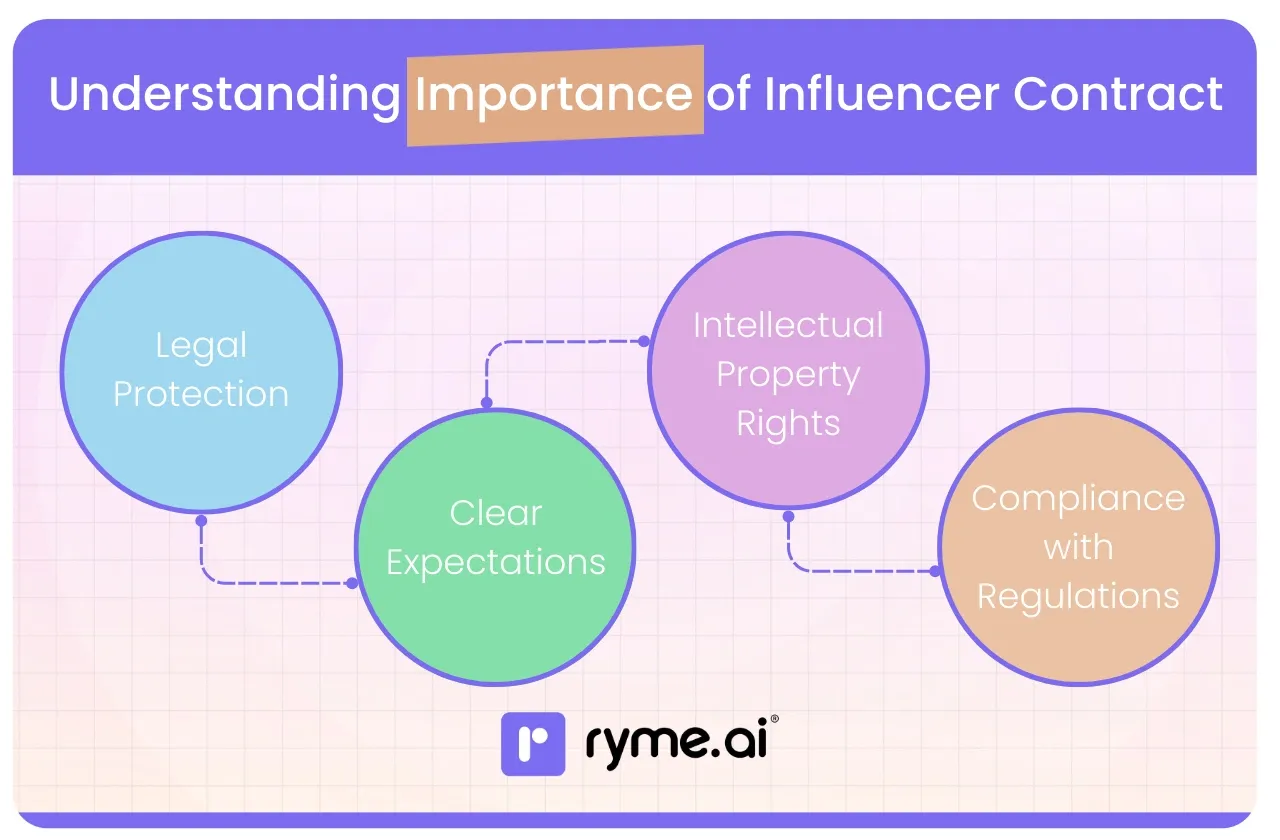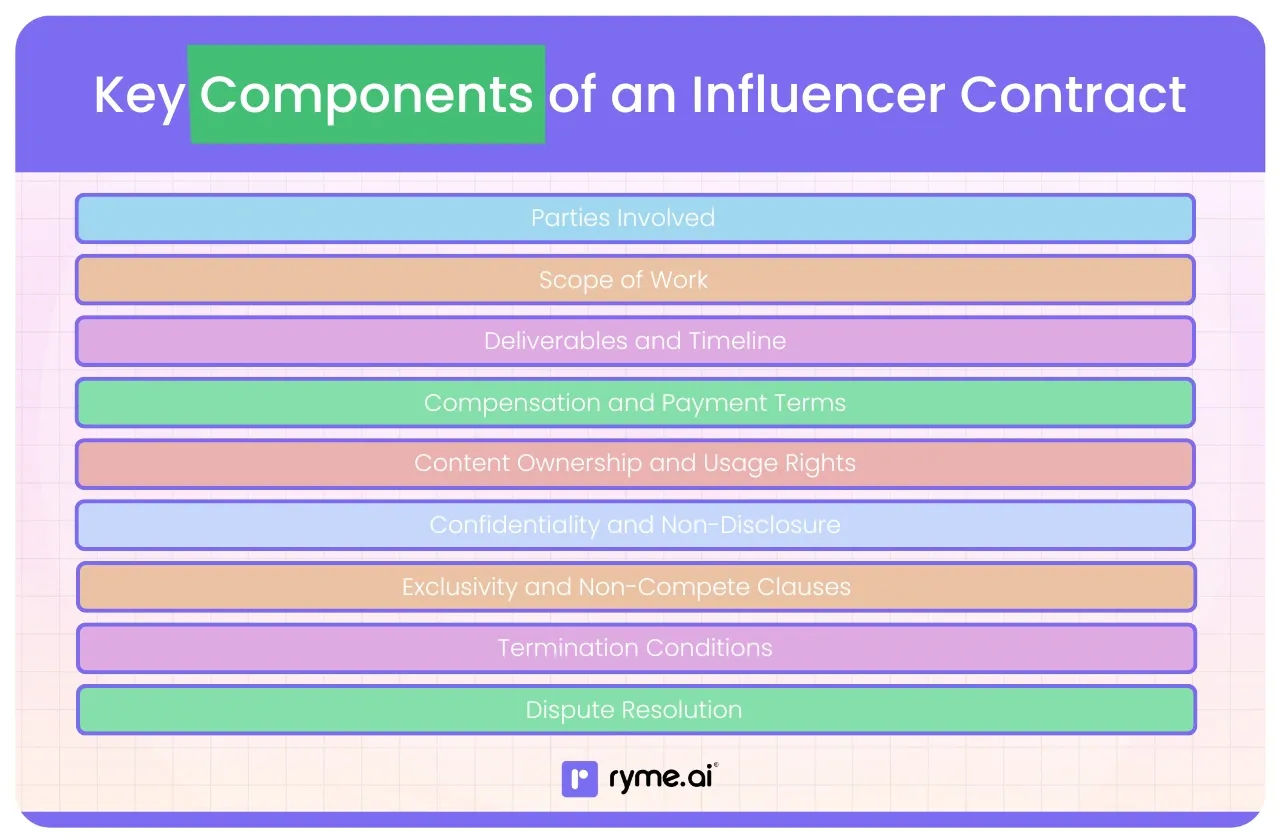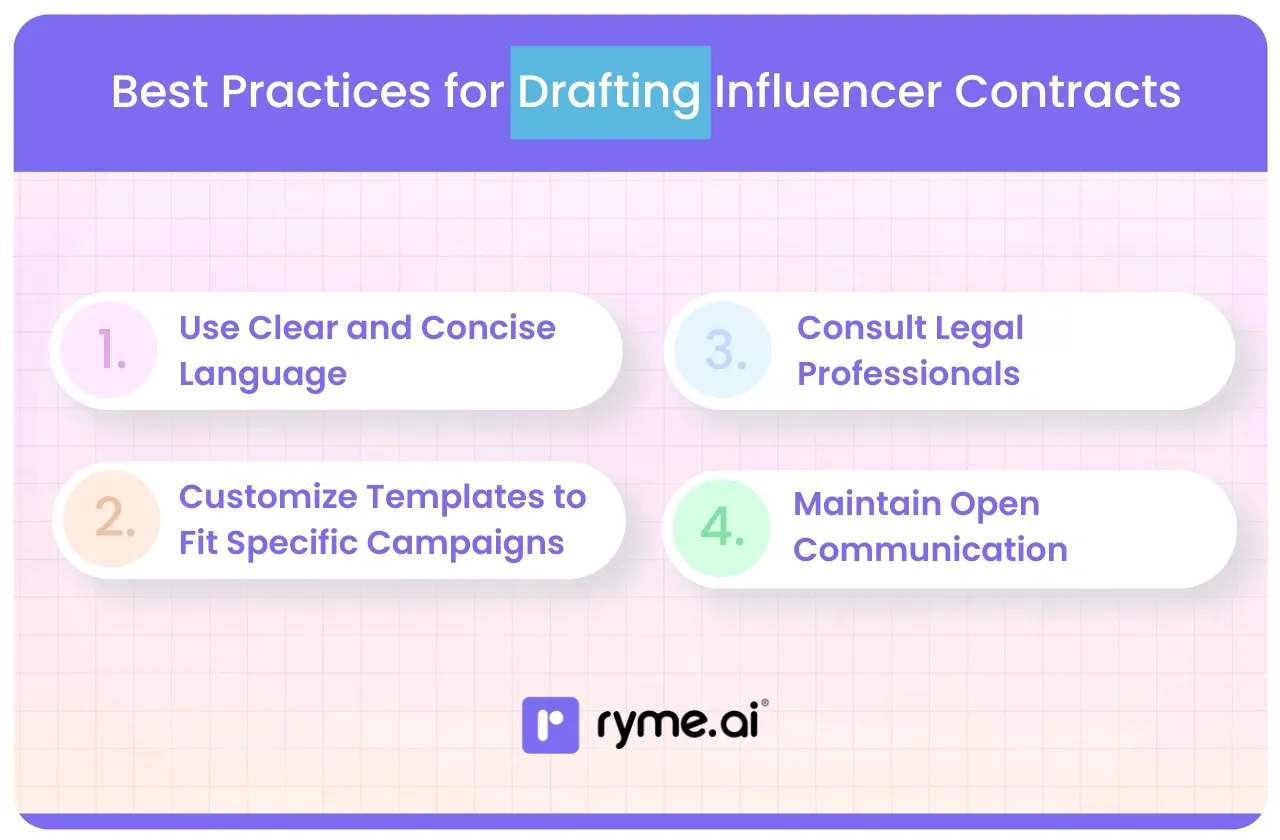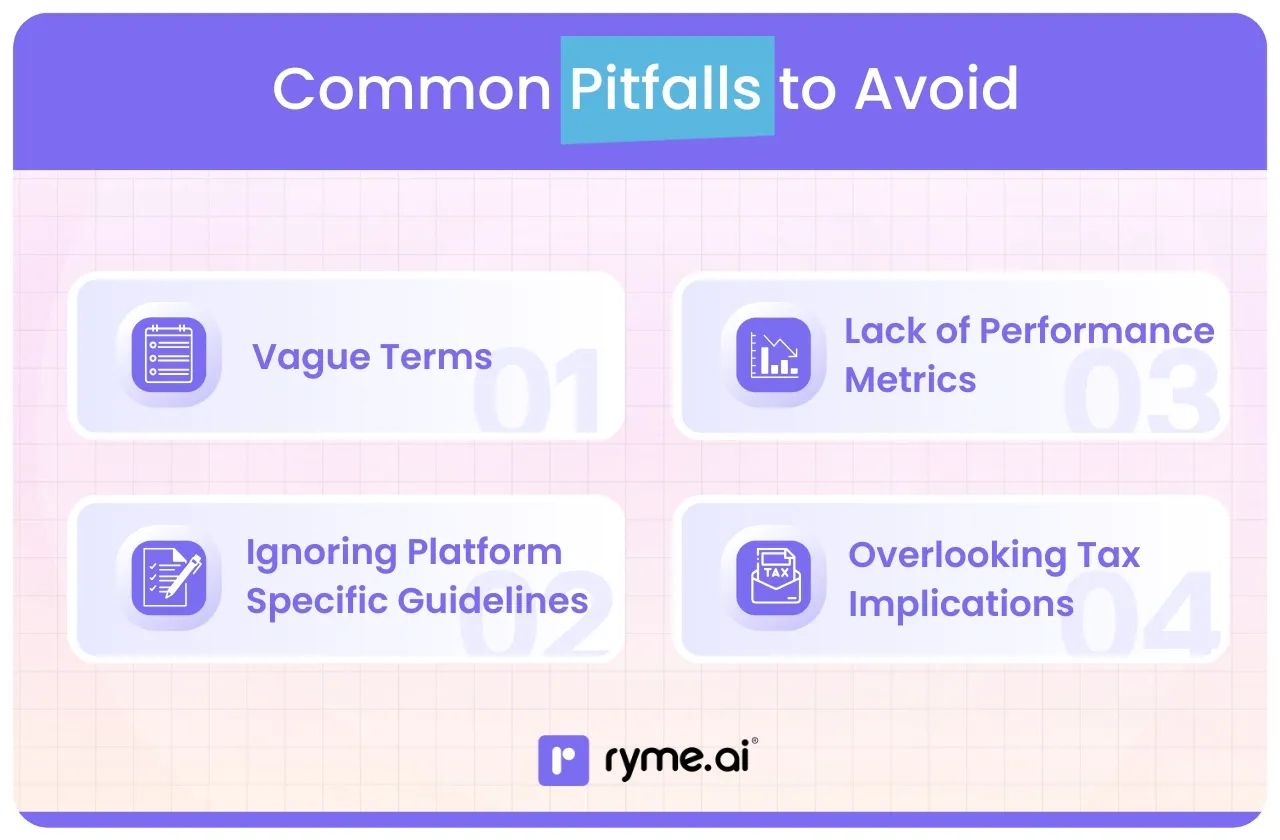Influencer Contract: Complete Info (2025)
Discover everything you need to know about influencer contracts! Get tips, templates, and insights to protect your brand and boost your collaborations.

Running a business and thinking about collaborating with influencers? Smart move! Influencer marketing is booming, especially here in India. But before you jump in, there's one crucial piece of the puzzle you absolutely need: a solid influencer contract.
Think of it like this: you wouldn't build a house without a blueprint, right? An influencer contract is your blueprint for a successful collaboration. It ensures everyone is on the same page, protects your brand, and helps you get the results you're looking for. Let's break down everything you need to know.
What is an Influencer Contract?
Simply put, an influencer contract is a legally binding agreement between your brand (or company) and an influencer. It clearly outlines the specific terms and conditions of your collaboration or campaign. It details what the influencer will do for your brand, what you will provide in return (usually payment or product), and the rules governing the partnership.
It’s not just a formality; it’s a fundamental tool for a smooth and professional working relationship. It moves your agreement from a casual chat or DM exchange into a formal business arrangement. This document defines the scope of work, deliverables, payment terms, content rights, timelines, and other essential elements. Having it all written down prevents misunderstandings and provides a clear reference point if questions or issues arise later. It's your safety net and your guide rolled into one. 📝
Understanding the Importance of an Influencer Contract
You might be thinking, "Is a formal contract really necessary, especially for smaller campaigns or micro-influencers?" The answer is a resounding YES! Trust us, skipping this step can lead to headaches, wasted money, and even legal trouble down the line. Let’s look at why it's so important:

A) Legal Protection
This is probably the most critical reason. Business relationships, even friendly ones, can sometimes hit bumps. What happens if the influencer doesn't deliver the promised content? Or if they post something that violates advertising standards? What if there's a dispute over payment?
A well-drafted influencer contract acts as your legal shield. It formally documents the agreement, clearly stating the rights and obligations of both your brand and the influencer.
- Defines Responsibilities: It explicitly states who is responsible for what. For instance, it confirms the influencer must create specific content and that your brand must pay an agreed amount by a certain date.
- Minimizes Disputes: When expectations and terms are clearly written and agreed upon, there's less room for misunderstanding or disagreement. If a dispute does occur, the contract provides a clear framework for resolving it based on the agreed terms, rather than relying on hazy recollections of conversations.
- Enforceability: A signed contract is legally enforceable. If one party fails to uphold their end of the bargain (e.g., the influencer ghosts you after receiving payment, or the brand refuses to pay after content is delivered), the contract provides the legal basis for seeking remedies, whether through negotiation, mediation, or, if necessary, legal action. It protects your investment and your brand's reputation.
- Think about it: without a contract, you're relying purely on trust and goodwill. While that's great, business requires a bit more certainty. A contract provides that certainty and protects you if things don't go as planned.
B) Clear Expectations
"Could you just do a few posts for us?" – This kind of vague instruction is a recipe for disaster! What does "a few" mean? What kind of posts? On which platform? By when?
An influencer contract eliminates this ambiguity by setting crystal-clear expectations. It ensures both you and the influencer are perfectly aligned on every aspect of the campaign before any work begins.
- Specific Deliverables: The contract should detail exactly what content the influencer needs to create. For example: "Two (2) Instagram Feed posts, each featuring the Product X prominently," or "One (1) dedicated YouTube video review (minimum 5 minutes long)," or "Three (3) Instagram Stories with a swipe-up link." It leaves no room for interpretation.
- Timelines and Deadlines: When do you need drafts for review? When should the content go live? A contract specifies these dates clearly (e.g., "Drafts due by May 10th, 2025; Final content live between May 15th-20th, 2025"). This keeps the campaign on track and ensures timely execution.
Content Guidelines: It outlines any specific requirements for the content itself. This can include:
- Key messages: What specific points about your product/service need to be mentioned?
- Tone of voice: Should it be funny, informative, aspirational?
- Visual requirements: Any specific branding elements, colours, or logos to include? Should the product be shown in a particular way?
- Call-to-action (CTA): What do you want the audience to do? (e.g., "Visit our website," "Use discount code XYZ," "Swipe up to shop.")
- Mandatory hashtags and tags: Specifying required hashtags (like #ad, #sponsored, your brand hashtag) and ensuring your brand's social media handles are tagged correctly.
- Things to avoid: Are there any topics, words, or visuals the influencer should steer clear of?
Getting all this down in writing ensures the influencer understands precisely what you need, and you know exactly what to expect. It prevents scope creep (where the requirements gradually expand) and reduces the need for constant back-and-forth clarification, saving everyone time and frustration.
C) Intellectual Property Rights
This is a big one that often gets overlooked. When an influencer creates content for your brand – photos, videos, blog posts, captions – who actually owns that content? And how can your brand use it?
The influencer contract is where you define ownership and usage rights for the content created during the campaign. Without this clarity, you could run into major issues.
- Content Ownership: Typically, the creator (the influencer) owns the copyright to the content they produce unless the contract explicitly states otherwise (e.g., through a "work-for-hire" clause, though this can be complex, or an assignment of rights). It's crucial to clarify this.
- Usage Rights (Licensing): More commonly, the contract grants your brand specific rights to use the influencer's content. This is called licensing. The contract needs to detail:
- What content can be used: Specific posts, images, videos?
- Where it can be used: On your brand's social media channels (organic posts)? On your website? In email marketing? In paid advertising (digital ads, print ads)?
- For how long: Can you use the content indefinitely (in perpetuity), or only for a limited time (e.g., 6 months, 1 year)? Usage rights in perpetuity often cost more.
- Content Modification: Can the content be modified? Can you crop images, add text overlays, or edit videos?
- Exclusivity of use: Can only your brand use this content, or can the influencer also use it on their channels (usually they retain this right
Defining these rights clearly protects your brand's ability to leverage the influencer-generated content (IGC) effectively. Imagine paying for fantastic content only to find out you can't use it in your paid ads or on your website because the contract didn't grant those rights! It also protects the influencer by ensuring their work isn't used in ways they didn't agree to. Clarity here prevents future disputes about content usage and potential copyright infringement claims.
D) Compliance with Regulations
Influencer marketing isn't the wild west anymore. There are rules and regulations you need to follow, particularly around advertising disclosures. In India, the Advertising Standards Council of India (ASCI) has specific guidelines for influencer advertising on digital media.
An influencer contract helps ensure both your brand and the influencer comply with these regulations, mitigating legal risks.
- Disclosure Requirements: The contract should explicitly state that the influencer must clearly and conspicuously disclose that their content is part of a paid partnership. This usually involves using hashtags like #ad, #sponsored, #partnership, #paidpromotion, or platform-specific tools (like Instagram's "Paid Partnership" tag). ASCI guidelines are quite specific about the prominence and clarity of these disclosures. The contract should reference these obligations.
- Content Accuracy: The contract can include clauses requiring the influencer's claims about the product/service to be truthful and not misleading. This aligns with general advertising laws preventing deceptive practices.
- Platform Rules: Social media platforms also have their own terms of service and branded content policies. The contract can require the influencer to adhere to these platform-specific rules as well.
- Indemnification: Often, contracts include clauses where the influencer agrees to indemnify the brand against claims arising from their failure to comply with laws or regulations (e.g., if they fail to disclose properly and the brand faces penalties).
By contractually requiring adherence to ASCI guidelines and other relevant regulations, you demonstrate due diligence and reduce the risk of penalties, fines, or reputational damage associated with non-compliant advertising.
It shifts some responsibility to the influencer to ensure they follow the rules, but ultimate responsibility often lies with the brand, making contractual clarity even more important. Recent ASCI reports highlight increasing scrutiny on influencer disclosures, making this a non-negotiable aspect.
In short, an influencer contract isn't just red tape; it's a vital business tool for protection, clarity, and compliance. It sets the foundation for a professional, transparent, and successful partnership.
Key Components of an Influencer Contract
Alright, now that you're convinced a contract is essential, let's break down what should actually go into it. Think of these as the essential chapters of your collaboration blueprint. A thorough contract will cover these key areas:

1) Parties Involved
This seems basic, but precision is key. You need to clearly identify exactly who is entering into this agreement.
- Brand: State the full legal name of your company, its registered address, and the contact person responsible for the campaign (including their title, email, and phone number). If you're an agency acting on behalf of a brand, clarify this relationship.
- Influencer: Get the influencer's full legal name (not just their social media handle!), their address, and their primary contact information (email/phone). If they operate under a business name or have an agent/manager, include those details as well.
- Why it matters: This ensures there's no confusion about who is legally bound by the contract's terms. Using legal names is crucial for enforceability.
2) Scope of Work (SOW)
This is the heart of the agreement, detailing exactly what the influencer is expected to do. Be specific! Vagueness here leads to problems.
Number and Type of Posts: Don't just say "social media posts." Specify:
- How many Instagram Feed posts?
- How many Instagram Stories (and how many frames per story)?
- How many Instagram Reels?
- Any YouTube videos (length, type – review, tutorial, integration)?
- Blog posts (word count)?
- TikTok videos?
- Tweets?
- Live streams?
Platforms: Clearly list the social media platforms where the content should be published (e.g., Instagram, YouTube, Facebook, Blog).
Content Requirements: Mention key messages, specific product features to highlight, mandatory tags (@YourBrand), required hashtags (#YourCampaign #ad #sponsored), any specific call-to-action (CTA), and links to include.
Approval Process: Detail how content drafts will be submitted, reviewed, and approved by your brand before going live. How many rounds of revisions are included?
Additional Responsibilities: Include anything else the influencer needs to do, such as:
- Attending an event (virtual or physical)?
- Participating in a Q&A session?
- Providing behind-the-scenes content?
- Responding to comments on the sponsored post for a certain period?
Example: "Influencer agrees to create and publish: Two (2) Instagram Feed posts featuring Product X; Five (5) Instagram Stories promoting the launch discount code 'NEWBRAND20'; One (1) dedicated YouTube video review (min. 8 minutes) demonstrating Product X usage. All content requires Brand approval prior to posting."
3) Deliverables and Timeline
Closely related to the SOW, this section focuses on when things need to happen. A campaign without deadlines is likely to drift.
- Draft Submission Deadline(s): Specify the date(s) by which the influencer must submit draft content (captions, images, video cuts) for your review.
- Brand Feedback Deadline(s): State how long your brand will take to provide feedback or request revisions. Be reasonable here.
- Final Content Approval Deadline(s): The date by which final content must be approved.
- Posting Schedule: Define the window during which the approved content must be published (e.g., "All Instagram posts to go live between June 1st and June 7th, 2025," or specific dates/times for each piece of content).
- Reporting Deadline: If applicable, state when the influencer needs to provide performance metrics or analytics (e.g., "Screenshots of post insights to be submitted within 7 days of posting").
- Why it matters: Timelines ensure the campaign aligns with your marketing calendar (e.g., product launches, seasonal promotions) and keeps everyone accountable.
4) Compensation and Payment Terms
Money matters! This section needs to be crystal clear to avoid any payment disputes. 💰
Compensation Amount: Clearly state the total fee you will pay the influencer. Specify the currency (e.g., Indian Rupees - ₹).
Payment Structure:
- Flat Fee: A fixed amount for the entire scope of work.
- Product Seeding: Providing free products/services in exchange for content (often for micro/nano influencers, but value should be clear). Ensure the value is understood, and potentially still offer a fee.
- Commission/Affiliate: Payment based on sales or leads generated through a unique tracking link or code.
- Hybrid: A combination (e.g., base fee + product + potential commission).
- Payment Schedule: When will the payment be made?
- Upfront: Full payment before work begins (less common, higher risk for brands).
Milestones: Partial payments upon completion of specific deliverables (e.g., 50% on signing, 50% on campaign completion). This is often fair to both parties.
Post-Campaign: Full payment after all deliverables are completed and approved (common, but might require influencer agreement). Specify the timeframe (e.g., "within 15 days of final post going live").
Payment Method: How will you pay? (e.g., Bank Transfer/NEFT, UPI, Cheque). Include details needed for payment (Bank Account details, PAN, GSTIN if applicable).
Expenses: Will you reimburse any expenses incurred by the influencer (e.g., travel for an event, costs for props)? Specify what is covered and the process for reimbursement (requires receipts).
Tax Considerations: Briefly mention that the influencer is responsible for their own income taxes. In India, clarify if TDS (Tax Deducted at Source) is applicable based on the payment amount and the influencer's status (individual, company) as per Income Tax rules. Mention if GST is applicable and who bears it (usually the brand pays the fee + applicable GST if the influencer is registered and provides a valid invoice).
Example: "Brand agrees to pay Influencer a total fee of ₹50,000 (Fifty Thousand Indian Rupees) plus applicable GST upon submission of a valid tax invoice. Payment schedule: 50% (₹25,000 + GST) upon contract signing, 50% (₹25,000 + GST) within 15 days of the final deliverable being published and approved. Payment via NEFT to the bank account provided by the Influencer. TDS will be deducted as per applicable Indian tax laws."
5) Content Ownership and Usage Rights
As discussed earlier, this is crucial. Define who owns the content and how your brand can use it.
Ownership: Clearly state who owns the intellectual property (IP) of the created content. Usually, the influencer retains ownership unless explicitly transferred (which often costs significantly more).
License Grant: Detail the license you are being granted. Be specific:
- Media: Which platforms/channels can you use it on? (e.g., Brand's Instagram, Facebook page, website blog, paid social ads, print marketing).
- Duration: For how long can you use it? (e.g., 6 months, 1 year, in perpetuity).
- Territory: Where can you use it? (e.g., India only, Worldwide).
- Modification Rights: Can you edit, crop, or add overlays?
- Exclusivity: Is the license exclusive to your brand, or can the influencer also use the content?
Example: "Influencer retains ownership of the copyright in the created content. Influencer grants Brand a non-exclusive, worldwide, royalty-free license to use, reproduce, display, and distribute the content on Brand's owned digital channels (website, Instagram, Facebook, Twitter) for a period of twelve (12) months from the date of the final post. Brand may repurpose content for organic social media use but requires separate written permission and potential additional compensation for use in paid advertising."
6) Confidentiality and Non-Disclosure
During the collaboration, you might share sensitive information with the influencer (e.g., upcoming product details, campaign strategy, performance data, pricing). A confidentiality clause protects this information.
- Definition of Confidential Information: Clearly define what constitutes confidential information.
- Obligation of Confidentiality: State that the influencer agrees not to disclose this information to any third party without your written consent, both during and after the campaign (specify a duration, e.g., 1-2 years post-contract).
- Exceptions: Include standard exceptions (e.g., information already publicly known, required by law).
- Why it matters: Protects your trade secrets and competitive advantage.
7) Exclusivity and Non-Compete Clauses
Do you need the influencer to work exclusively with your brand in your category for a certain period? If so, you need an exclusivity clause.
- Exclusivity: Specify if the influencer cannot work with competing brands during the campaign period. Define "competing brands" clearly (e.g., "any other skincare brand," "direct competitors listed in Annex A"). Be reasonable in scope and duration.
- Non-Compete: Sometimes extends exclusivity for a short period after the campaign ends (e.g., 30-60 days). This is harder to enforce and must be narrowly defined and reasonable to be valid. Influencers may charge more for exclusivity.
- Why it matters: Prevents the influencer from promoting a direct competitor immediately before, during, or shortly after your campaign, which could dilute your message or confuse their audience.
8) Termination Conditions
What happens if things go wrong? This section outlines the conditions under which either party can end the contract prematurely.
Grounds for Termination: List valid reasons, such as:
- Material Breach: Failure by either party to fulfil a major obligation (e.g., influencer doesn't post, brand doesn't pay). Usually requires a notice period to fix the breach.
- Influencer Misconduct: If the influencer engages in behaviour that harms your brand's reputation (e.g., scandal, offensive posts).
- Bankruptcy/Insolvency: If either party becomes insolvent.
- Mutual Agreement: Both parties agree to end the contract.
- Notice Period: Specify how much written notice is required for termination (unless it's for a severe breach).
- Consequences of Termination: What happens upon termination? (e.g., payment for work completed up to the termination date, return of confidential information, cessation of content usage rights).
- Why it matters: Provides a clear exit strategy if the partnership isn't working out, protecting both parties from further loss or damage.
9) Dispute Resolution
How will disagreements be handled if they can't be resolved amicably?
- Governing Law: Specify which country's or state's laws will govern the contract (e.g., "the laws of India").
- Jurisdiction: Specify the location where legal proceedings would take place (e.g., "the courts of Mumbai, Maharashtra").
- Resolution Method: Outline the preferred process:
- Good Faith Negotiation: Require parties to first try to resolve the issue through direct discussion.
- Mediation: Suggest using a neutral third-party mediator to help reach a resolution (often faster and cheaper than court).
- Arbitration: Agreeing to have a neutral arbitrator make a binding decision outside of court.
- Litigation: Filing a lawsuit in court (usually the last resort).
- Why it matters: Sets a clear path for handling disputes, potentially avoiding costly and time-consuming court battles.
Having these components clearly defined in your influencer contract creates a solid foundation for your collaboration, ensuring transparency and minimizing potential issues.
Best Practices for Drafting Influencer Contracts
Okay, you know what needs to go into the contract. Now, let's talk about how to approach drafting it effectively. Following these best practices will make the process smoother and the outcome better for everyone involved.

1) Use Clear and Concise Language
Remember who you're communicating with. While it's a legal document, it shouldn't require a law degree to understand.
Avoid Legalese: Ditch the overly complex legal jargon wherever possible. Instead of "heretofore" or "aforementioned," use simpler terms like "before" or "mentioned above."
Be Specific: Use precise language. Instead of "reasonable efforts," define what those efforts entail if possible. Instead of "timely manner," specify dates or timeframes.
Define Key Terms: If you use terms that could be ambiguous (like "deliverables," "campaign period," "confidential information"), include clear definitions within the contract.
Structure for Readability: Use headings, subheadings, bullet points, and short paragraphs to break up the text and make it easier to scan and understand.
The goal: Both you and the influencer should clearly understand every clause and its implications without needing constant translation. This fosters trust and reduces the chance of misunderstandings based purely on confusing language. 🤔
2) Customize Templates to Fit Specific Campaigns
It's tempting to find a generic influencer contract template online and use it for every campaign. Resist this urge! While templates are a great starting point, one size rarely fits all in influencer marketing.
Tailor the Scope: Each campaign is unique. Adjust the Scope of Work, Deliverables, and Timelines sections meticulously to match the specific requirements of this particular collaboration. Are you launching a new product? Running a contest? Driving traffic for a sale? The contract needs to reflect these goals.
Adjust for Influencer Tier: The contract for a mega-influencer with millions of followers might need different clauses (e.g., stricter exclusivity, higher fees, detailed usage rights) than one for a nano-influencer receiving product only.
Platform Specifics: If the campaign heavily relies on a specific platform like Instagram Reels or YouTube, ensure the contract addresses any nuances related to that platform (e.g., music usage rights for Reels, YouTube's specific disclosure requirements).
Consider Campaign Goals: If the main goal is generating sales via an affiliate link, the compensation and tracking clauses will be very different than if the goal is purely brand awareness.
Think of it like tailoring a suit: A template gives you the basic shape, but you need to adjust the measurements and details for a perfect fit. Customizing the contract ensures it's relevant, accurate, and effectively governs the specific campaign you're running.
3) Consult Legal Professionals
While you should aim for clear language, influencer contracts are legal documents with real consequences. Especially for high-value campaigns or long-term partnerships, getting legal advice is crucial.
Review Before Sending: Have a lawyer experienced in contract law and, ideally, digital marketing or intellectual property law review your template and specific campaign contracts before you send them to influencers.
Ensure Compliance: A lawyer can help ensure your contract complies with current laws and regulations, including advertising standards (like ASCI guidelines), consumer protection laws, intellectual property laws, and tax regulations in India.
Risk Assessment: They can identify potential risks or loopholes in your contract and suggest revisions to better protect your brand's interests.
Negotiation Support: If an influencer requests significant changes or pushes back on certain clauses, legal counsel can advise you on the implications and help you negotiate effectively.
Yes, it's an added cost, but consider it an investment. The cost of legal advice upfront is often far less than the potential cost of resolving a dispute, facing regulatory penalties, or dealing with IP issues down the line. For smaller brands or initial campaigns, you might start with a solid template reviewed once by a lawyer, but always be cautious.
4) Maintain Open Communication
A contract shouldn't feel like a rigid set of demands dropped on the influencer. It should be the formalization of a mutually agreed-upon partnership. Foster open and transparent communication throughout the process.
Discuss Before Drafting: Have a clear conversation with the influencer about the campaign expectations, deliverables, compensation, and key terms before you even send the contract. This ensures you're broadly aligned from the start.
Present the Contract Clearly: When you send the contract, don't just attach it to an email. Briefly explain its purpose and highlight the key sections. Invite the influencer to review it carefully.
Be Open to Questions: Encourage the influencer to ask questions or raise concerns. Be prepared to explain clauses in simpler terms and discuss potential modifications.
Negotiate Reasonably: Influencers (especially established ones) may have their own standard terms or request changes. Be open to reasonable negotiation on points like usage rights duration, payment schedule, or minor wording changes. Knowing your non-negotiables beforehand is helpful.
Document Changes: If any changes are agreed upon during negotiation, make sure they are clearly documented in the final version of the contract before signing.
Building rapport: Approaching the contract process collaboratively builds trust and sets a positive tone for the partnership. An influencer who feels respected and heard is more likely to be engaged and deliver great results. Remember, it's a collaboration, not a dictatorship! 😊
By following these best practices, you can create influencer contracts that are clear, fair, legally sound, and contribute to positive and productive partnerships.
Common Pitfalls to Avoid
Navigating influencer collaborations can be exciting, but there are common traps brands fall into, especially regarding contracts. Being aware of these pitfalls can help you steer clear and ensure smoother campaigns.

1) Vague Terms
We touched on this earlier, but it bears repeating: ambiguity is your enemy in a contract. Vague language is a breeding ground for misunderstandings and disputes.
- The Problem: Phrases like "promote the product," "a few posts," "timely delivery," or "standard usage rights" are open to interpretation. What one person considers "promotion," another might not. "Timely" can mean different things to different people.
- The Consequence: You might expect three detailed Instagram posts, while the influencer delivers two quick Stories. You might assume you can use the content in ads, but the influencer believes usage is limited to organic social. This leads to disappointment, conflict, and potentially needing to redo work or pay extra.
- The Solution: Be hyper-specific. Define everything clearly. Instead of "promote," specify "create one Instagram Reel showcasing the product's ease of use." Instead of "timely," provide exact dates. Instead of "standard usage," detail the exact platforms, duration, and types of use allowed. Spell. It. Out.
- Think: If there's any room for doubt about what a term means, clarify it or define it within the contract.
2) Lack of Performance Metrics (KPIs)
You're investing time and money (or product) into this collaboration. How will you know if it was successful? Relying on gut feelings isn't enough.
The Problem: The contract focuses solely on the creation of content (e.g., "post 3 times") but fails to mention any goals or metrics for performance.
The Consequence: You have no clear way to measure the campaign's effectiveness or calculate Return on Investment (ROI). Was the goal reach? Engagement? Website traffic? Sales? Without defined Key Performance Indicators (KPIs), you can't objectively assess success or failure, making it hard to justify future influencer marketing spend or optimize future campaigns.
The Solution: While you can't always contractually guarantee results (like a specific number of sales), you can include clauses related to tracking and reporting.
- Specify the key metrics you want to track (e.g., reach, impressions, engagement rate, link clicks, story views, conversions using a specific code/link).
- Require the influencer to provide screenshots or access to their analytics data for the sponsored content within a specific timeframe after posting.
- Set clear campaign goals upfront (even if not strictly in the contract's payment terms) so both parties understand what success looks like.
Knowing your numbers: Defining and tracking KPIs helps you understand what's working, demonstrate value, and make data-driven decisions for future collaborations.
3) Ignoring Platform-Specific Guidelines
Each social media platform (Instagram, YouTube, TikTok, etc.) has its own rules, features, and best practices, especially concerning branded content and disclosures.
The Problem: Creating a generic contract that doesn't consider the specific platforms being used for the campaign.
The Consequence: You or the influencer might inadvertently violate platform terms of service. For example:
- Failing to use Instagram's "Paid Partnership" tag when required.
- Violating YouTube's policies on embedding links or disclosures in videos.
- Running contests or giveaways that don't comply with platform rules. This can lead to content being removed, account penalties, or reduced visibility.
The Solution: Familiarize yourself (and ensure the influencer is aware of) the specific branded content policies and disclosure requirements for each platform included in the campaign. Reference these obligations in the contract, perhaps stating that the influencer must comply with all applicable platform terms of service, including branded content policies.
Play by the rules: Adhering to platform guidelines ensures your content stays live, reaches its intended audience, and avoids any negative action from the platforms themselves.
4) Overlooking Tax Implications
Payments made to influencers are generally considered taxable income for them, and there can be tax obligations for your brand as well. Ignoring this can lead to legal and financial headaches.
The Problem: Failing to consider or clarify tax responsibilities in the contract or during payment processing.
The Consequence:
For the Brand (India): If payments exceed certain thresholds (currently ₹30,000 per transaction or aggregate in a financial year for professional/technical services under Section 194J, or potentially Section 194R for benefits/perquisites, including high-value products), your business may be required to deduct TDS (Tax Deducted at Source) before paying the influencer and deposit it with the government.
Failure to do so can result in penalties and interest. You also need to consider GST – if the influencer is registered for GST, they will charge GST on their invoice, which your business can typically claim as an input tax credit (if you are also registered).
For the Influencer: They need to declare the income (cash or value of products) and pay income tax on it. Unclear expectations can lead to confusion when they receive a payment less TDS, or if they weren't aware they needed to handle GST.
The Solution:
- Include a clause stating the influencer is responsible for their own income taxes.
- Clearly state in the payment terms whether the agreed fee is inclusive or exclusive of applicable GST.
- Mention that TDS will be deducted as per applicable Indian tax laws if required. Request the influencer's PAN and GSTIN (if applicable) for compliance purposes.
- Consult with your accountant or a tax advisor to ensure you understand your brand's specific TDS and GST obligations regarding influencer payments and product gifting.
Don't ignore the taxman! Properly addressing tax implications from the outset prevents nasty surprises for both parties and ensures legal compliance. 🧾
Avoiding these common pitfalls requires diligence and attention to detail when drafting and executing your influencer contracts. Taking the time to be specific, compliant, and aware of potential issues will save you significant trouble in the long run.
Leveraging Software in Influencer Contract Management
Managing multiple influencer collaborations, especially as your program grows, can become complex. Keeping track of contracts, deliverables, payments, and communications manually is time-consuming and prone to errors. Thankfully, technology can help streamline this process.
A) Digital Contract Platforms
These platforms are designed specifically for creating, sending, signing, and storing contracts electronically. They offer several advantages over traditional paper contracts or simple PDF email exchanges.
- Efficiency: Quickly create contracts using pre-approved templates. Send them to influencers for review and signature with just a few clicks.
- E-Signatures: Legally binding electronic signatures eliminate the need for printing, scanning, and mailing documents, speeding up the contract finalization process significantly. Platforms like DocuSign, HelloSign, or Adobe Sign are common examples (though many influencer platforms have this built-in).
- Centralized Storage: Keep all your influencer contracts organized and easily accessible in one secure digital location. No more searching through emails or file cabinets.
- Tracking and Reminders: Monitor the status of contracts (sent, viewed, signed). Some platforms offer automated reminders for key dates or renewals.
- Version Control: Easily track changes and revisions made during negotiations, ensuring everyone signs the final, correct version.
- Go digital: Using these platforms saves time, reduces administrative burden, enhances security, and provides a clear audit trail for all your agreements.
B) Integration with Campaign Management Tools
The real power comes when contract management doesn't exist in a silo. Integrating contract details with your broader influencer campaign management tools creates a more cohesive and efficient workflow.
- Connecting Terms to Tasks: Link specific contract deliverables (e.g., "2 Instagram posts by June 15th") directly to tasks or milestones within your campaign management software. This makes it easy to track if influencers are meeting their contractual obligations.
- Content Approval Alignment: Ensure the content approval process within your management tool aligns with the review timelines and requirements set out in the contract.
- Performance Tracking: Connect contract terms (like usage rights duration) with performance data. Track how content performs during the period you have rights to use it.
- Holistic View: See contract status, deliverables, content drafts, performance metrics, and communication history all related to a specific influencer or campaign in one place.
- Seamless workflow: Integration eliminates the need to constantly switch between different systems or manually cross-reference contract terms with campaign progress. It provides a unified view for better oversight and management.
C) Automation of Payment Processes
Paying influencers accurately and on time is crucial for maintaining good relationships. Automating this process based on contract terms can save significant time and prevent errors.
- Milestone-Based Payments: Set up automated payment triggers based on the completion of contractual milestones (e.g., automatically schedule the final payment once the last deliverable is marked as approved and published in your campaign tool).
- Invoice Generation/Processing: Some systems can help generate payment requests or integrate with accounting software to streamline the processing of influencer invoices according to the agreed payment schedule in the contract.
- Reduced Manual Effort: Minimizes the need for manual tracking of payment due dates and amounts, reducing the risk of missed or incorrect payments.
- Transparency: Provides both the brand and the influencer with clear visibility into payment status and schedules.
- Get paid (and pay) easier: Automating payments based on contract terms ensures compliance, improves efficiency, and helps maintain positive influencer relationships by ensuring timely compensation.
Leveraging software solutions for contract creation, management, and payment can transform your influencer marketing operations from a potentially chaotic process into a streamlined, efficient, and scalable function. Platforms specifically designed for influencer marketing often incorporate many of these features.
ryme.ai – Revolutionizing Influencer Collaborations
Speaking of platforms that streamline the process, let's talk about ryme.ai. If you're feeling overwhelmed by the complexities of finding influencers, managing campaigns, and ensuring you get value for your budget, ryme.ai is designed to help brands like yours.
ryme.ai is an AI-powered influencer collaboration platform built to make connecting with the right influencers simpler, more efficient, and remarkably cost-effective. It tackles many of the common headaches brands face in the influencer marketing space.
Features Beneficial to Brands
ryme.ai offers several features specifically designed to make your life easier and your campaigns more successful:
1) Zero-Commission Model
This is a game-changer, especially for small to medium-sized businesses or those just starting with influencer marketing.
- The Problem: Traditional influencer agencies often charge hefty commissions (typically 15-30%) on top of the influencer fees, significantly increasing campaign costs. Minimum campaign budget requirements can also be a barrier.
- ryme.ai's Solution: ryme.ai operates on a zero-commission basis. You pay the influencer fee, but you don't pay an extra percentage to the platform for the connection or campaign management tools. There are no minimum budget requirements, making it accessible whether you're planning a small campaign with micro-influencers or a larger activation. This means more of your budget goes directly towards the talent and content creation, maximizing your ROI.
2) AI-Powered Influencer Matching
Finding influencers whose audience genuinely aligns with your target customer is crucial for campaign success. Scrolling endlessly through Instagram isn't efficient.
- The Problem: Manually searching for influencers is time-consuming and often relies on guesswork or vanity metrics (like follower count) that don't guarantee relevance or engagement.
- ryme.ai's Solution: The platform uses sophisticated AI algorithms to analyze vast amounts of data. It goes beyond simple follower counts to understand an influencer's audience demographics (age, location, interests), content style, engagement rates, and past performance. You define your target audience and campaign goals, and the AI recommends influencers whose followers closely match your ideal customer profile and whose content resonates with that audience. This data-driven approach significantly increases the likelihood of finding authentic and effective partners, saving you hours of manual research. 🎯
3) Robust Analytics and Reporting
Measuring the impact of your influencer campaigns is vital. You need data, not just anecdotes.
- The Problem: Tracking performance across multiple influencers and platforms can be messy. Gathering data manually is tedious, and getting real-time insights is often difficult.
- ryme.ai's Solution: ryme.ai provides a centralized dashboard with real-time analytics and comprehensive reporting. Track key metrics like reach, impressions, engagement (likes, comments, shares), click-through rates, conversions (if using trackable links/codes), and overall campaign ROI. Visual dashboards make it easy to understand performance at a glance, compare influencer results, and identify what's working best. These insights allow you to make informed decisions, optimize campaigns mid-flight, and clearly demonstrate the value of your influencer marketing efforts to stakeholders. 📊
4) Streamlined Content Approval Workflows
The back-and-forth process of reviewing and approving influencer content can become a bottleneck.
- The Problem: Managing drafts, feedback, revisions, and final approvals via email or DMs can be chaotic, leading to delays, missed feedback, and frustration for both brands and influencers.
- ryme.ai's Solution: The platform offers streamlined content approval workflows. Influencers submit drafts directly through the platform. Your team can review, provide specific feedback, request revisions, and give final approval all within one organized system. This creates a clear communication trail, reduces delays, ensures brand guidelines are met, and makes the collaboration process much smoother and more efficient for everyone involved. ✅
Addressing Common Pain Points
ryme.ai directly tackles some of the most frequent challenges brands encounter in influencer marketing:
1) High Costs and Tight Budgets
- Pain Point: Influencer marketing seems expensive due to agency fees and perceived high influencer rates. Budgets are often limited.
- ryme.ai's Relief: The zero-commission model drastically reduces overhead costs. The no minimum budget requirement, meaning brands of any size can participate. The AI matching helps find cost-effective micro and nano-influencers who often have high engagement rates and niche audiences, providing great value.
2) Finding the Right Influencers
- Pain Point: It's hard and time-consuming to identify influencers who are truly authentic, have an engaged audience that matches the brand's target demographic, and align with brand values.
- ryme.ai's Relief: The AI-driven matching system takes the guesswork out of discovery. By focusing on audience data, engagement quality, and content relevance, it connects brands with influencers who are the most likely to drive meaningful results.
3) Lack of Actionable Insights
- Pain Point: Difficulty in measuring the true ROI of influencer campaigns and understanding what's actually working. Reports are often basic or delayed.
- ryme.ai's Relief: Real-time analytics and robust reporting provide clear, actionable data. Brands can instantly see campaign performance, understand audience engagement, track conversions, and make data-backed decisions to optimize spending and strategy.
4) Content Approval Headaches
- Pain Point: The content review and approval process is often slow, disorganized, and leads to friction between brands and influencers.
- ryme.ai's Relief: Efficient, centralized workflows simplify the entire process. Clear communication channels, easy feedback tools, and status tracking reduce bottlenecks and ensure content goes live on time and meets brand standards, fostering better relationships. 👍
By leveraging AI and focusing on efficiency and cost-effectiveness, ryme.ai aims to democratize influencer marketing, making it easier for brands in India and beyond to build successful, data-driven collaborations.
Conclusion
Whew! We've covered a lot of ground, haven't we? From understanding the absolute necessity of an influencer contract to diving deep into its key components, best practices, and potential pitfalls – you're now armed with the knowledge to approach influencer collaborations with confidence.
Remember, an influencer contract isn't about mistrust; it's about clarity, protection, and professionalism. It's the bedrock of a successful partnership, ensuring both your brand and the influencer understand the rules of the game, the expectations, and the rewards. It transforms a casual agreement into a solid business arrangement, safeguarding your investment and maximizing your chances of achieving those campaign goals.
Ultimately, successful influencer marketing relies on strong relationships built on transparency and mutual understanding. A well-crafted contract is the foundation for that relationship. So, go forth, find those amazing influencers, build strong partnerships, and make sure you have that solid contract in place before you kick things off! You've got this! 🎉
Influencer Contract Related FAQs
Let's quickly tackle some common questions that often pop up regarding influencer contracts and collaborations:
1) What is an influencer contract?
An influencer contract is a legally binding agreement between a brand (or agency) and an influencer. It outlines the specific terms of their collaboration, including the scope of work (what the influencer will do), deliverables (specific content to be created), timelines, compensation (payment or product), content ownership and usage rights, disclosure requirements, and other key rules governing the partnership. It serves to provide legal protection, set clear expectations, define content rights, and ensure compliance with regulations.
2) How much do influencers get paid?
Ah, the million-rupee question! 🤑 There's no single answer, as influencer compensation varies wildly. Key factors influencing payment include:
- Reach: Follower count across platforms (Instagram, YouTube, etc.). Mega-influencers with millions command much higher fees than nano-influencers with a few thousand.
- Engagement Rate: How actively does their audience interact (likes, comments, shares)? High engagement is often valued more than just high follower count.
- Niche: Influencers in specialized or high-demand niches (like finance, niche tech, luxury) may charge more.
- Platform: Video content (YouTube, Reels) generally requires more effort and often commands higher fees than static image posts.
- Scope of Work: The number and type of deliverables, complexity of content, and required effort heavily influence the price.
- Usage Rights: Granting brands extensive usage rights (especially for paid ads or long durations) significantly increases the cost.
- Exclusivity: If the brand requires exclusivity (preventing the influencer from working with competitors), this comes at a premium.
- Location/Demographics: Audience location and demographics can impact rates, especially if targeting a specific region like India.
Rates can range from free product or a few thousand rupees (₹) for nano/micro-influencers to lakhs or even crores of rupees (₹₹₹) for top-tier celebrities and mega-influencers for extensive campaigns. Platforms like ryme.ai can help you find influencers that fit various budget levels.
3) What are the 3 R's of influencer marketing?
The "3 R's" are a common framework used to evaluate potential influencers:
- Reach: How many people can the influencer potentially reach? This relates to their follower count and audience size. While important, it's only one piece of the puzzle.
- Relevance: How relevant is the influencer's content and audience to your brand and target market? An influencer reaching millions is useless if those millions aren't interested in your product/service. Alignment with your brand values and niche is key.
- Resonance: How deeply does the influencer connect with their audience? This is reflected in their engagement rate (likes, comments, shares relative to follower count) and the authenticity of their relationship with their followers. High resonance often leads to greater trust and influence.
Brands should consider all three R's when selecting influencers, often prioritizing Relevance and Resonance over just Reach.
4) What is the commission for influencer agents?
When influencers work with agents or managers, these agents typically take a commission from the deals they secure for the influencer. This commission is usually a percentage of the influencer's total earnings from the campaign.
- Typical Range: The standard commission rate for influencer agents often falls between 10% and 20%. However, it can sometimes be higher (up to 25-30%) depending on the agent's services, the influencer's status, and the specifics of the deal negotiated.
- Who Pays: This commission is typically paid by the influencer to their agent out of the fee they receive from the brand. It's not usually an additional cost paid directly by the brand, unless the agreement structure is different (e.g., the agency invoices the brand for the total amount including their commission).
Platforms like ryme.ai, with their zero-commission model for brands, offer an alternative to the traditional agency fee structure, making collaborations more direct and cost-effective for the brand.
Actionable Checklist: Nailing Your Influencer Contract
Before you launch your next influencer campaign, run through this quick checklist:
✅ Identify Parties Clearly: Full legal names and contact info for both brand and influencer?
✅ Define Scope of Work: Specific number/type of posts, platforms, and any extra duties detailed?
✅ Set Timelines: Draft submission, feedback, approval, and posting dates included?
✅ Specify Compensation: Exact amount (in ₹), payment method, schedule (milestones?), and tax responsibilities (TDS/GST) clear?
✅ Outline Content Usage Rights: Where can you use the content (organic, paid ads, website)? For how long? Any modification rights?
✅ Include Disclosure Requirements: Mandate clear #ad / #sponsored disclosures per ASCI guidelines?
✅ Add Confidentiality Clause: Protect sensitive campaign/product info?
✅ Consider Exclusivity: Needed? Clearly defined competitors and duration?
✅ Detail Termination Conditions: Grounds and consequences outlined?
✅ Specify Dispute Resolution: Governing law, jurisdiction, and preferred method (mediation?) included?
✅ Use Clear Language: Avoid jargon, define terms?
✅ Customize the Template: Tailored to this specific campaign?
✅ Consult Legal Counsel: Especially for significant campaigns? (Strongly recommended!)
✅ Communicate Openly: Discussed terms with the influencer before sending? Open to questions?
✅ Check Platform Compliance: Aware of specific rules for Instagram, YouTube, etc.?
✅ Review Pitfalls: Avoided vague terms, included KPIs (or tracking), considered tax?
✅ Consider Management Tools: Explored platforms (like ryme.ai 😉) for efficiency?



